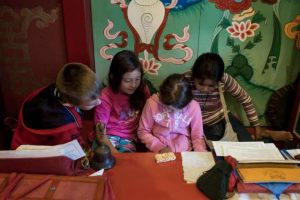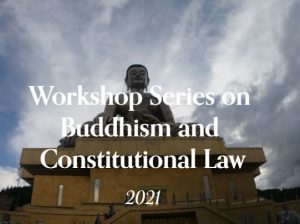Standardization, codification, and notation are ways of enshrining the culture of dance. There are many examples in history. At the same time, those same efforts to unify, categorize, and draw up authoritative systems can have a chilling effect: the fossilization of a living thing, the watering down of nuanced distinctions in favor of a recognized generalized form. The case of a Tibetan folk dance called Gorshey provides an example of a very old dance: fast and furious; danced to a banging eight-count rhythm that accelerates with each successive section; in costumes with enormously long sleeves; cutting a unique and blazing display on whatever landscape the dance takes place. Songs accompany these dances, performed by men and women together singing in a call-and-response fashion. Historically, Gorshey was sung and danced by the participants. These days, all manner of recorded music is used.
Today, the Gorshey folk dance has become somewhat controversial as a sign of Tibetan political resistance, and its practice is banned in some places—both within and without the historical region of Tibet. Gor means circle, and she means dance, aptly describing the circular formation of dancers when holding hands. Gorshey’s origins are debated, but it appears to predate recorded history, traveling easily over a widespread area of historical Tibet.
Gorshey is a social dance deeply embedded in Tibetan culture, performed at various celebrations, such as festivals, weddings, and religious gatherings. It fosters community spirit, joy, and shared experience, transcending individual differences and uniting participants in a common rhythm, a lively dance, a romp. Gorshey is a happy dance.
Dancers move in a counterclockwise circle, with varying steps and formations, depending on the region and occasion. The basic step involves a hop on one foot followed by a step with the other, often accompanied by swinging arm gestures and singing. Different communities have their own styles and variations, adding unique flavors to the dance. For example, some incorporate acrobatic elements, while others emphasize intricate footwork. Some of the earliest films made in Tibet by Westerners depict raucous Gorshey dances. Botanist Joseph Rock (1884–1962) made excellent films of Gorshey dances.

While China acknowledges and promotes diverse ethnic dances, including the Gorshey, concerns exist regarding potential homogenization, appropriation, and standardization initiatives by the Chinese government—such as incorporating ballet techniques. These might—even if inadvertently based on high-minded motives—erase the specific cultural nuances and meanings embedded in the dance. Some efforts at dance notation may, in fact, contribute to cultural erasure. A cultural dance should have agency for the participant cultures, not agency for a dominating power.
The situation that Gorshey finds itself in today was a long time coming and is a complex story of dance, national initiatives, and the adoption of Western modalities of dance, dance research, and dance notation. It is important to remember that modern China is not so old. The establishment of national dance policies, ethnic policies and labels, and an arts system that trains artists at a national level, all came to be in the 20th century.
Among the most influential figures in developing the modern Chinese dance establishment was a most unusual dancer and scholar, Eileen Issac, a Trinidadian national, born to a Chinese expatriate family and a mother who enrolled her into ballet lessons at seven years old. At age 15, she moved to London, where she studied with the top dancers in classical ballet, including Sir Anton Dolin; in creative choreography, Dame Marie Rambert; and finally with a German master of raw expressionism in choreography, Kurt Joos, famous as a mentor of the late great Pina Bausch.
Sometime after she entered the London dance scene, Issac changed her name to Dai Ailian, an invented Chinese name quite likely suggested by Dolin as more exotic and useful onstage as a dancer, and emphasizing her Chinese looks. These were the same days when a talented Irish dancer named Edris Stannus, joined the Ballet Russe, becoming Ninette de Valois in the process. Dame Ninette went on to found the Royal Ballet. Dai Ailian, a formidable force in the development of modern Chinese dance culture, built her reputation on a bogus Chinese stage name given to her by a ballet director in London. This symbolizes much of what is problematic about Dai Ailian and her pioneering if misguided efforts to build a national Chinese dance culture. It also shows a China ready to adopt Western ideas of dance, dance research, and performance.
This greater topic is too vast for this article, so I will move directly to Dai Ailian spearheading a national survey and recording of folk dances for China. Words matter. The citizens of the regions that are home to what China now calls its “56 Ethnic Minorities” do not refer to themselves as ethnic minorities of China. This was the construct that Dai Ailian used. She writes about Gorshey—obviously a very old Tibetan dance—as something that grew out of Chinese dances during the Tang dynasty (618–907). This is pure fabrication, and as such is doubly confounding. The subject of the dance influence of the Tang dynasty on the rest of Asia is a brilliant, unexplored topic. Here it is tossed off as an assertion, a rationalization, as a national propaganda about dance origins, appropriating the Tibetan dances as essentially Chinese. Dai Ailian (Eileen Issac) accepts this unconditionally—something that a foreigner could possibly do; something that a member of the featured ethnic group and culture would likely contest in a recording of their own dances.
Without putting too fine a point on it: a Trinidadian woman using an almost vaudevillian name, Dai Ailian, was recording Tibetan Gorshey dance as a remnant of China’s Tang dynasty, in fact as a Chinese folk dance, as part of China’s 56 Ethnic Minorities. How do we understand the legitimacy—or otherwise—of this type of record? And she used Labanotation, a system akin to Western music notation, invented by European draftsman Rudolf von Laban, during the period of Ailian’s young training. These records still exist and are complete records of the Gorshey dances inasmuch as they are recorded start to finish, and the music is included, along with cultural notes, however skewed.

One criticism of Labanotation is that it is fundamentally incommensurate with Asian dances, being a Western mechanistic method. This is a parallel criticism of Western musical notation used to transcribe non-Western music. The Chinese government is not interested in spiritual elements, and so this mechanistic record of dance was deemed suitable. It standardized and, at the same time, neutered the dances. What’s more, it became a way of codifying history; of owning the dances.
These days, Labanotation is primarily used in legal cases of copyright dispute; with the Labanotation record offered as evidence, proving the ownership of a dance. Where China is defining the dance in ways Tibetans would not, it is, at the same time, producing a mechanistic recording that they own, that proves all their assertions by becoming the historical record. The Chinese have long believed in the power of written records of history. Chinese culture has acknowledged the power of dance perhaps more than any other country. Writing dance history is a powerful route to ownership.
These issues with Tibetan folk dance do not have a parallel with Buddhist monastic cham dances, which have been spared the treatment of the folk dances. Although cham is regulated in China, as religion is, the dance has not been reduced to something it is not. Cham is not a part of secular dance shows as it is in Mongolia.
The Gorshey dance is still in the news, as its public performance is banned in Chinese cities, and in some former Tibetan-majority areas outlawed as an unsanctioned public assembly. All told, this is a kind of cultural erasure. The making of a UNESCO-style promotional national dance, on a proscenium stage, facing front, in flashy costumes, danced by professional, ballet-trained dancers from an archaic Tibetan folk dance that embodies Tibetan identity, is a strategic way to homogenize, dilute, re-label, exploit, and erase a culture.
In 2018, New York dancer Mark Bankin visited and then attended the Minority University in Beijing to study folk dances. It was there that he met Tibetan teachers of Tibetan culture, and saw his first Gorshey dance in an impromptu outdoor performance in Beijing. He was struck by the characteristics of the dance, and noticed the tensions between practitioners of ethic dances and the government of China. He joined the group dances. He grew determined to make records of Gorshey himself, so that his version—not informed by the same Chinese ideals—might offer a counter record.

A word about China’s obsessive controls over danced expression. With a survey and initiative to make records of dances, it is just a few short steps from codifying authorized versions of dances, and from there not far to make certain dances legal and illegal. The example of the “granny dances” in China is surprising and revealing. Granny dances are a popular description for fun, simple dances performed in outdoor groups in big cities, accompanied by happy music, and enjoyed by elderly people. Pleasant enough. Over time, these gatherings became louder and louder, the music loonier and more percussive, and the senior citizens more adamant about their right to dance together.
Naturally, creativity blossomed and grannies started making up their own granny dances with new music and more varied choreography. The events grew bigger and louder and generated more complaints . . . until the national government stepped in and banned the creation of new granny dances. It went further, introducing a set of—I think it was 12—government-approved granny dances, taught on video by a clean-looking fellow wearing what looked like an airport technician’s jumpsuit. It is not at all far-fetched to understand China’s dance and ethnic policies as ones of domination and erasure through homogenization and standardization.
Bankin went on to be awarded a Fulbright fellowship to study notation and apply it to Gorshey dances. He attended the Conservatoire National Supérieur de Musique et de Dans de Paris, where he studied Kinetography Laban, known in the US as Labanotation. It was there that Bankin produced 15 notations of Gorshey dance segments based on dances he had seen, performed himself, and remembered. He also used recorded dances and established points of contact with the Tibetan diaspora. Bankin’s notations are seeking a final home, where they can join the historical record of scholarship around these dances.
It is almost a David-and-Goliath story to think that a humble New York choreographer might right the wrongs committed against cultural practices within China’s political sphere, nevertheless, with Labanotation serving as one form of dance writing that can stand the test of time, future scholars will see that there was another approach: that of a fellow dancer who was amazed by a dance, and wanted to be sure it could be preserved for posterity in its original beauty and power.

See more
Related features from BDG
Writing Dance in Stone, Part One
Stillness
Tantric Bodies, Tantric Dance
Nabji, Part One: Bearing Relics



















During my trip to Tibet last year, I had the opportunity to witness a traditional dance performance, the Cham Dance, not Gorshey. The dancers, with their graceful movements, melodious singing, and magnificent costumes, created a rich Tibetan cultural atmosphere. Their dance was both a continuation of historical traditions and a passionate expression of contemporary life. As the article describes, dance is a social activity that can promote community spirit, and bring shared joy and experiences. Therefore, I deeply feel the importance of dance in cultural heritage and have a deeper understanding of the issues of cultural standardization and codification mentioned in the article. While standardization and codification help protect cultural traditions, we also need to consider how to balance the protection of traditions with the drive for innovation to ensure the diversity and vitality of culture.